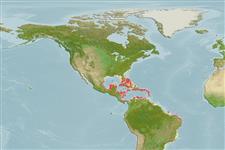Actinopterygii (ray-finned fishes) >
Beloniformes (Needle fishes) >
Belonidae (Needlefishes)
Etymology: Platybelone: Greek, platys = flat + Greek, belone = needle; any fish with sharp pointed snout; also Pierre Belon, 1517-64, French zoologist born in Le Mans. Professor at the College de France, author of " La nature et diversité des poissons", 1551 (Ref. 45335).
Issue
Issue on validity of subspecies: subspecies considered as valid in FB, elevated to species rank as Platybelone argalus (Lesueur, 1821) in Eschmeyer (CofF ver. Mar. 2011: Ref. 86697). Please send references, or more studies are needed.
Environment / Climate / Range
Ecology
Marine; reef-associated; depth range 0 - ? m, usually 0 - 2 m (Ref. 40849). Subtropical, preferred ?; 37°N - 29°S, 98°W - 34°W
Western Atlantic: North Carolina, USA to Brazil (Ref. 7251), including the Bahamas, Gulf of Mexico, and Caribbean Sea.
Size / Weight / Age
Maturity: Lm ? range ? - ? cm
Max length : 50.0 cm TL male/unsexed; (Ref. 26340); common length : 35.0 cm TL male/unsexed; (Ref. 5217)
Dorsal
soft rays
(total): 12-15;
Anal
soft rays: 17 - 20. Gill rakers present; caudal peduncle with a lateral keel, the lateral line passing ventral to it.
Occurs offshore; particularly abundant around islands (Ref. 5217); schools in sheltered parts of the reef (Ref. 48635). Feeds mainly on small fishes. Oviparous (Ref. 205). Eggs may be found attached to objects in the water by tendrils on the egg's surface (Ref. 205).
Life cycle and mating behavior
Maturity | Reproduction | Spawning | Eggs | Fecundity | Larvae
Böhlke, J.E. and C.C.G. Chaplin, 1993. Fishes of the Bahamas and adjacent tropical waters. 2nd edition. University of Texas Press, Austin. (Ref. 5521)
IUCN Red List Status (Ref. 115185)
CITES (Ref. 94142)
Not Evaluated
Threat to humans
Harmless
Human uses
Fisheries: subsistence fisheries
More information
ReferencesAquacultureAquaculture profileStrainsGeneticsAllele frequenciesHeritabilityDiseasesProcessingMass conversion
Tools
Special reports
Download XML
Internet sources
Estimates of some properties based on models
Phylogenetic diversity index (Ref.
82805): PD
50 = 0.7500 [Uniqueness, from 0.5 = low to 2.0 = high].
Trophic Level (Ref.
69278): 4.5 ±0.8 se; Based on diet studies.
Resilience (Ref.
69278): Medium, minimum population doubling time 1.4 - 4.4 years (Preliminary K or Fecundity.).
Vulnerability (Ref.
59153): Moderate vulnerability (39 of 100) .
